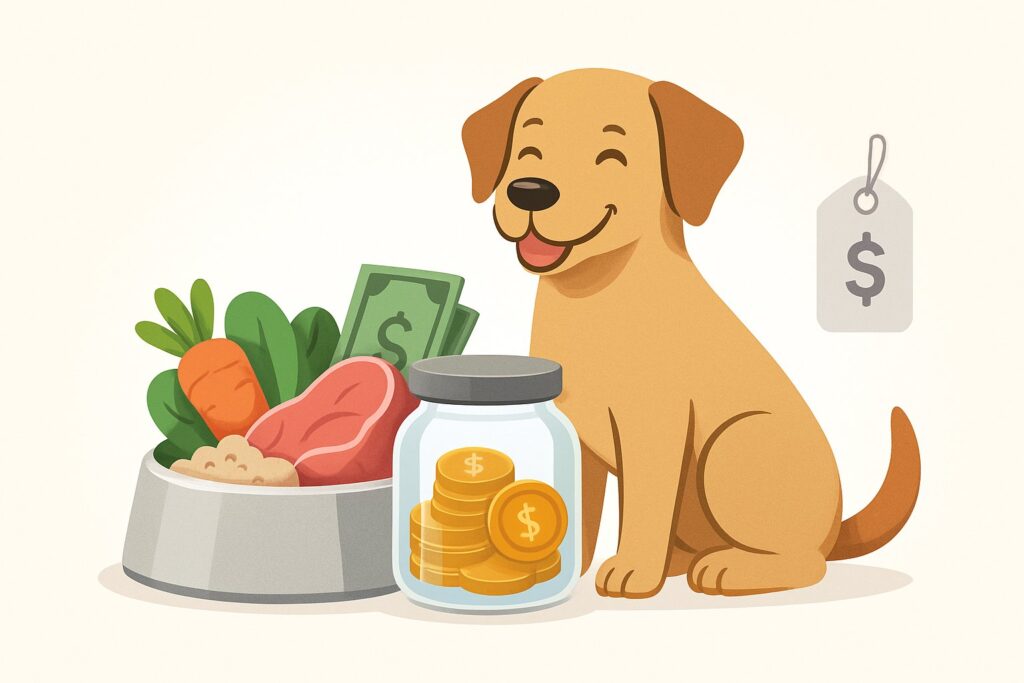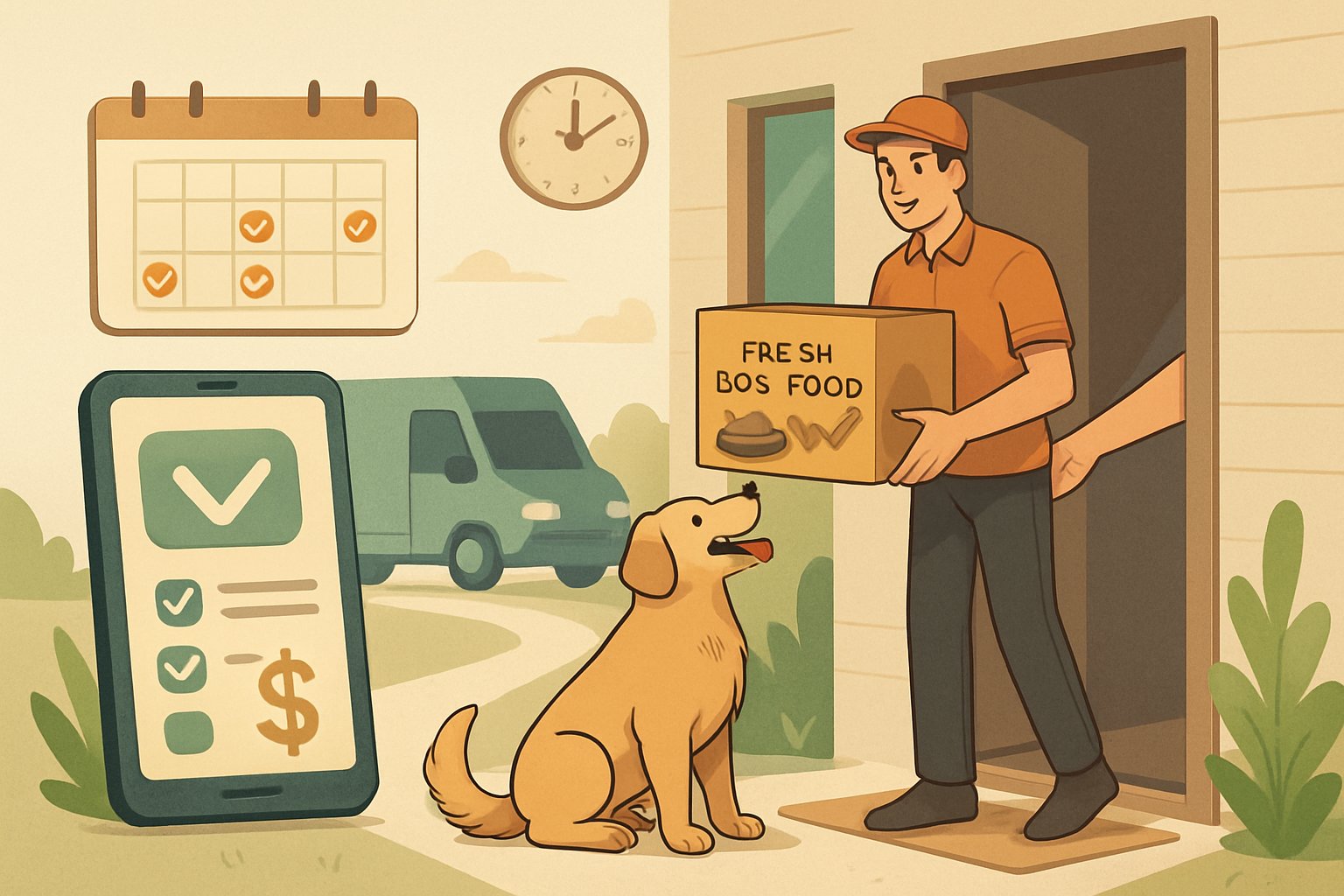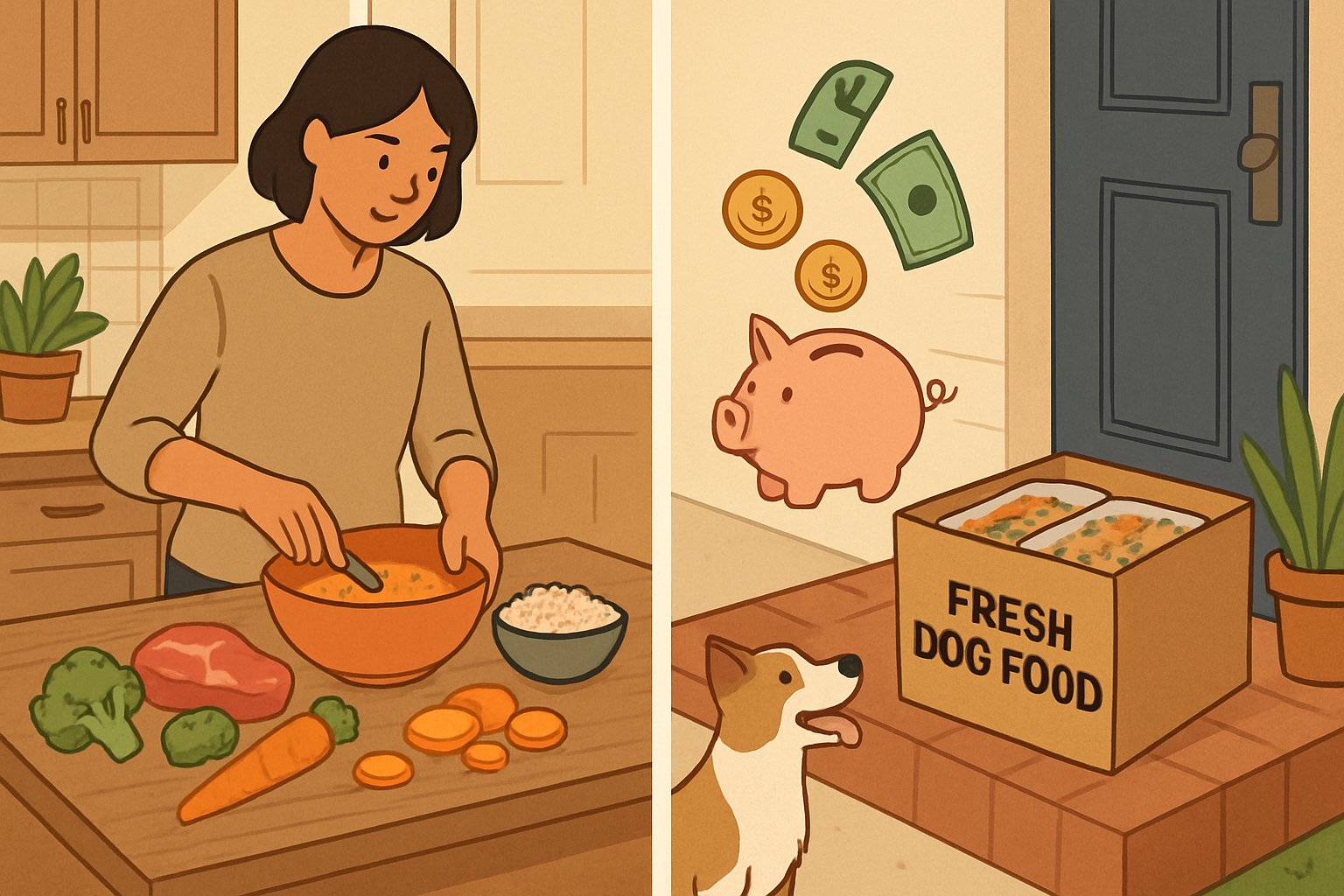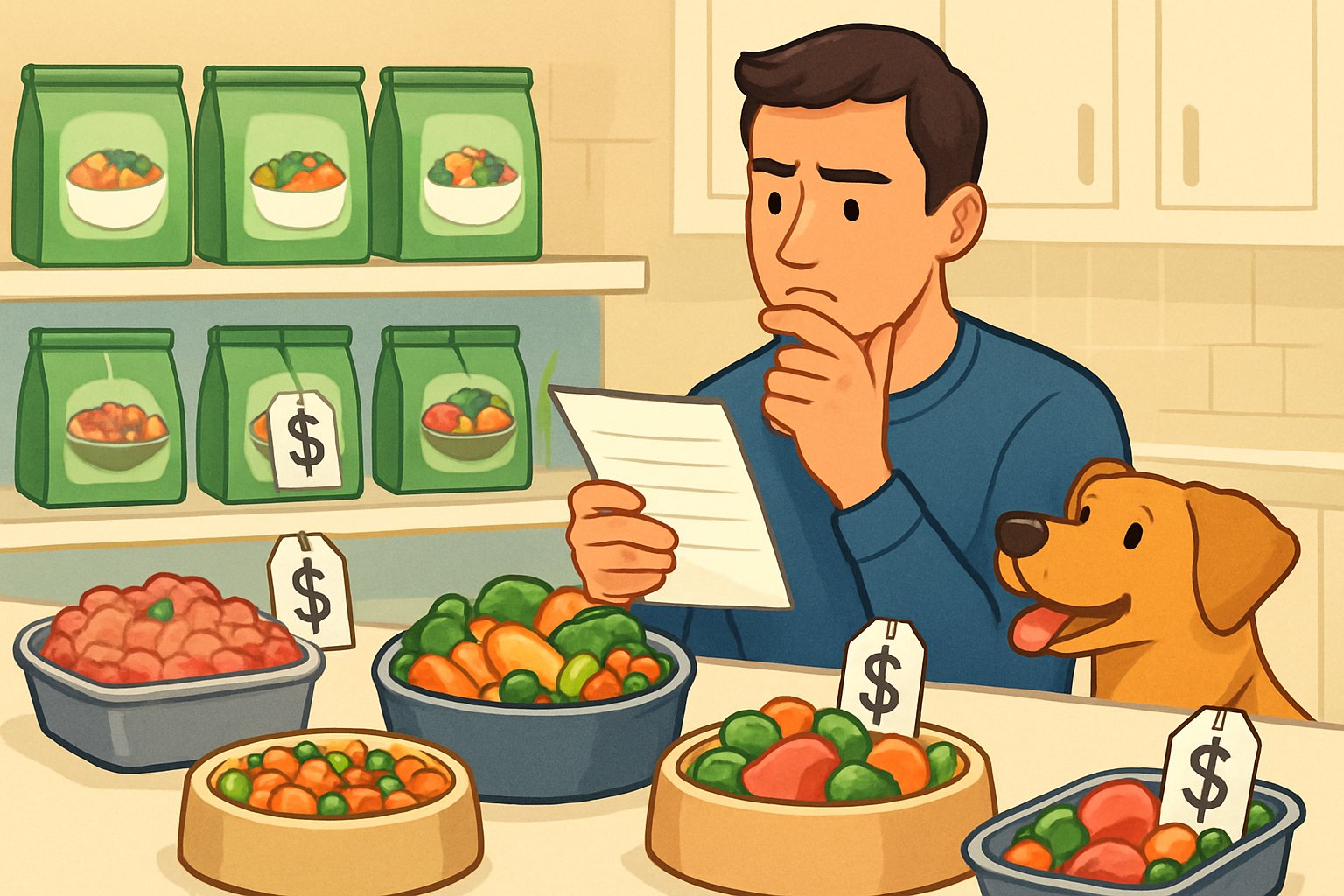I’ve been feeding my dog fresh food for over two years now, and the number one question I get from fellow pet parents is always about cost. Fresh dog food typically costs 2-3 times more than traditional kibble, ranging from $3-8 per day depending on your dog’s size and the brand you choose. But here’s what most people don’t realize – that price difference isn’t as scary as it sounds when you break down what you’re actually getting.

Table of Contents
Let me be honest with you. When I first looked at fresh dog food prices, I nearly choked on my coffee. My wallet wasn’t exactly jumping for joy at the thought of spending $150+ per month on dog food. But after watching my pup’s energy levels soar and his coat become ridiculously shiny, I started digging deeper into where that money actually goes.
You’re about to discover exactly what drives fresh dog food costs, how subscription services stack up against DIY options, and whether homemade versus commercial diets actually save you money. I’ll break down the real numbers, share some sneaky ways to cut costs, and help you figure out if your dog’s health improvements are worth the investment.
Key Takeaways
- Fresh dog food costs 2-3 times more than kibble but offers significantly higher nutritional value and quality ingredients
- Making homemade fresh food can reduce costs by 30-50% compared to commercial fresh food delivery services
- The investment often pays off through reduced vet bills and improved dog health over time
What Drives Fresh Dog Food Cost?
Fresh dog food pricing stems from premium human-grade ingredients, custom meal planning by pet nutritionists, and specialized cold-chain shipping requirements. These three factors create the biggest cost differences compared to traditional kibble.
Ingredient Quality and Sourcing
I’ve noticed that human-grade ingredients make up the largest portion of fresh dog food cost. These premium proteins like grass-fed beef, free-range chicken, and wild-caught salmon cost 3-4 times more than conventional pet food ingredients.
The sourcing matters too. Many fresh dog food companies work directly with farms that meet USDA human food standards. This means stricter quality controls, organic certifications, and higher labor costs.
Here’s what drives ingredient costs higher:
- USDA-certified facilities for processing
- Organic produce sourced from verified farms
- Fresh vegetables instead of dried meal alternatives
- No by-products or fillers commonly used in kibble
When pet owners prioritize health and nutrition over price, they’re willing to pay more for these premium ingredients. The difference is like comparing a fast-food burger to a farm-to-table meal.
Personalized Meal Plans vs Standard Recipes
Custom meal plans created by a pet nutritionist cost significantly more than one-size-fits-all recipes. I’ve seen companies charge 40-60% more for personalized formulations based on your dog’s age, weight, activity level, and health conditions.
Standard recipes use bulk production methods that keep costs lower. But personalized plans require:
- Individual nutritional analysis
- Custom portion calculations
- Specialized ingredient combinations
- Regular plan adjustments
Some fresh dog food services offer both options. The standard recipes work well for healthy dogs, while personalized plans target specific needs like weight management or food allergies.
The choice between them often determines if you’ll pay $3 per day or $8 per day for the same sized dog.
Packaging and Shipping Expenses
Cold-chain shipping makes up 20-30% of your total cost of fresh dog food. Unlike dry kibble that ships at room temperature, fresh meals need refrigerated trucks and insulated packaging.
The logistics get expensive fast:
- Dry ice or gel packs for temperature control
- Insulated boxes that cost $8-12 each
- Express shipping to maintain freshness
- Regional distribution centers to reduce shipping distances
Most companies ship weekly or bi-weekly to spread these costs across multiple meals. But if you live in remote areas, expect higher shipping fees.
I’ve found that subscription services help reduce these expenses by optimizing delivery routes and bulk packaging. Single orders always cost more per meal due to the fixed shipping overhead.
The packaging itself uses food-grade materials that meet the same standards as human food delivery services. This attention to safety and freshness adds cost but ensures your dog gets meals that haven’t spoiled during transit.
Price Breakdown: Fresh Dog Food vs Kibble and Other Options
When I started researching fresh dog food cost, I discovered the daily expense can range from $3 to $12 per dog, while kibble typically costs $1 to $4 daily. The price difference becomes clearer when you break down cost per pound and understand what you’re actually paying for in each option.
Average Daily and Monthly Costs
Let me be real with you — fresh dog food will hit your wallet harder than kibble. For a 50-pound dog, I’ve found fresh food costs between $5-8 daily, which adds up to $150-240 monthly.
Kibble runs much cheaper at $1.50-3 per day for the same size dog. That’s roughly $45-90 monthly. The price gap is significant.
Here’s what I’ve seen for different dog sizes:
Small Dogs (10-20 lbs):
- Fresh: $2-4 daily ($60-120 monthly)
- Kibble: $0.75-1.50 daily ($23-45 monthly)
Medium Dogs (30-50 lbs):
- Fresh: $4-7 daily ($120-210 monthly)
- Kibble: $1.25-2.50 daily ($38-75 monthly)
Large Dogs (70+ lbs):
- Fresh: $7-12 daily ($210-360 monthly)
- Kibble: $2-4 daily ($60-120 monthly)
The math gets tougher with multiple dogs. I know owners spending $300+ monthly on fresh food for two medium dogs.
Comparing Fresh, Kibble, and Canned Dog Food
Fresh dog food consistently ranks as the most expensive option I’ve researched. Premium fresh brands like Nom Nom or The Farmer’s Dog charge $3-6 per pound.
Kibble pricing breaks down like this:
- Budget brands: $1-2 per pound
- Mid-range: $2-4 per pound
- Premium: $4-8 per pound
Canned food sits in the middle at $2-5 per pound. But here’s the kicker — you need more canned food per serving than kibble due to water content.
I’ve noticed that fresh dog foods were significantly more expensive than dry alternatives, which matches my own price comparisons. The processing and refrigeration costs drive fresh food prices higher.
Value considerations I’ve found:
- Fresh food offers higher protein density
- Kibble provides longest shelf life
- Canned food balances cost with nutrition better than I expected
Understanding Cost Per Pound and Serving
This part trips up most dog parents I talk to. Cost per pound doesn’t tell the whole story — you need to calculate cost per serving based on your dog’s needs.
A 40-pound dog needs roughly 1,000-1,200 calories daily. Here’s how that translates:
Fresh Food:
- 1.5-2 pounds needed daily
- At $4/pound = $6-8 daily cost
Kibble:
- 2.5-3 cups needed daily (about 1 pound)
- At $2.50/pound = $2.50 daily cost
The difference comes from calorie density. Fresh food packs more calories per ounce than most kibble.
I always tell people to calculate by serving, not by bag size. That $80 bag of premium kibble might last 6 weeks, while $80 of fresh food lasts maybe 10 days.
Package size helps determine the total package cost, so I recommend doing the math per meal to get real costs.
Pro tip: Factor in shipping costs for fresh food delivery — usually $10-20 weekly — when calculating your true cost per serving.
Subscription Services and Delivery: Convenience at a Price

Fresh dog food subscription services deliver premium meals straight to your door, but you’ll pay significantly more than traditional kibble. Most services charge between $40-120 per month depending on your dog’s size and dietary needs.
Overview of Fresh Dog Food Delivery Services
Let me be honest – I was skeptical about fresh dog food delivery services until I saw how much time they actually save.
These services work like meal kits for humans. You answer questions about your dog’s age, weight, activity level, and food preferences. The company creates custom meal plans and ships frozen or fresh food to your home.
What makes them different from regular dog food:
- Human-grade ingredients
- Custom portion sizes for your specific dog
- No preservatives or artificial additives
- Recipes developed by veterinary nutritionists
The convenience factor is huge. No more lugging heavy bags from the store or wondering if you’re feeding the right amount.
Most companies ship monthly or bi-weekly. The food arrives in insulated boxes with ice packs to keep everything fresh during delivery.
Popular Brands and What They Charge
I’ve researched the top players in this space, and the pricing varies dramatically based on your dog’s size.
The Farmer’s Dog charges roughly $2-12 per day depending on your dog’s weight. A 50-pound dog costs about $75 per month.
Ollie runs slightly higher at $3-12 daily. Their recipes include options like beef with sweet potatoes and turkey with blueberries.
PetPlate typically costs $2-8 per day. They focus on simple ingredients and offer a 30% discount on your first order.
Here’s what I found for a 30-pound dog:
| Brand | Monthly Cost | Cost Per Day | Shipping |
|---|---|---|---|
| The Farmer’s Dog | $50-65 | $1.67-2.17 | Free |
| Ollie | $55-70 | $1.83-2.33 | Free |
| PetPlate | $45-60 | $1.50-2.00 | Free |
All major dog food brands in this space offer free shipping, but you’re locked into subscription commitments.
What’s Included in a Typical Subscription
When your first box arrives, you’ll get more than just food. Most meal delivery services include detailed feeding instructions and transition guides.
Standard subscription contents:
- Pre-portioned meals in individual containers
- Feeding schedule based on your dog’s needs
- Storage instructions and expiration dates
- Customer support contact information
The meals come frozen or refrigerated in eco-friendly packaging. You’ll typically receive 1-4 weeks worth of food depending on your delivery frequency.
Many services include extras like treats, supplements, or feeding accessories. Some offer veterinary consultations as part of premium plans.
Subscription flexibility varies by company:
- Pause deliveries when traveling
- Adjust portion sizes as your dog grows
- Switch between recipes
- Cancel anytime (though some require advance notice)
Research shows that customers prioritize price, product quality, and personalization when choosing subscription services. The convenience comes at a premium, but many dog owners find the time savings worth the extra cost.
Is Fresh Dog Food Worth the Price Tag?
When I first considered switching to fresh dog food, the sticker shock nearly made me walk away. Fresh dog food typically costs 3-5 times more than traditional kibble, but the health benefits and peace of mind might justify every penny for many pet parents.
Health Benefits and Ingredient Transparency
Let’s be real — I used to grab whatever bag of kibble was on sale. Then I started reading labels.
Human-grade ingredients make a massive difference in digestibility and nutrition. Fresh dog food companies use ingredients you’d recognize in your own kitchen: real chicken, sweet potatoes, and leafy greens.
Here’s what shocked me most:
- Better nutrient absorption — fresh food is up to 90% digestible versus 70% for kibble
- Shinier coats within 2-3 weeks of switching
- More energy and better weight management
- Reduced dental issues from less processed ingredients
The transparency factor hits different too. When I can see actual chunks of vegetables and meat, I know exactly what my dog is eating. No mystery meal or by-products.
Most fresh food brands list every single ingredient with clear sourcing. That level of transparency is worth something, especially when health and wellness attributes are becoming increasingly important in pet food purchasing decisions.
Role of Pet and Veterinary Nutritionists
Here’s where things get interesting. Most fresh dog food companies employ veterinary nutritionists to formulate their recipes.
These aren’t just pet lovers with good intentions. They’re board-certified professionals who understand canine nutrition at a molecular level.
When I spoke with a pet nutritionist about my dog’s needs, she explained how fresh food allows for better customization. Unlike kibble manufacturers who create one-size-fits-all formulas, fresh food companies can adjust recipes based on:
- Age and activity level
- Breed-specific requirements
- Individual health conditions
- Weight management goals
The oversight matters more than I initially realized. A veterinary nutritionist ensures every recipe meets AAFCO standards while maximizing bioavailability of nutrients.
That expertise costs money, but it’s reflected in better-balanced meals. My vet actually noticed improvements in my dog’s bloodwork after six months on fresh food.
Managing Food Allergies and Special Diets
If your dog has food allergies, fresh food becomes less of a luxury and more of a necessity.
I learned this the hard way when my rescue developed severe skin irritation. Traditional elimination diets with limited ingredient kibble weren’t cutting it.
Fresh food companies make it incredibly easy to avoid problem ingredients:
Common allergens they eliminate:
- Chicken (for poultry-sensitive dogs)
- Grains and gluten
- Artificial preservatives
- Common fillers like corn and soy
The customization options are game-changing. I can literally select recipes that avoid my dog’s specific triggers.
Limited ingredient fresh foods typically contain 5-8 ingredients versus 30+ in typical kibble. This makes identifying problem foods much simpler.
For dogs with chronic digestive issues, the gentle nature of fresh food often provides relief within days. The reduced processing means less stress on sensitive stomachs.
Yes, fresh food costs more upfront. But when I factor in reduced vet visits for allergy-related issues, the math starts making sense.
The peace of mind knowing exactly what goes into every meal? That’s priceless for anxious pet parents dealing with food sensitivities.
DIY or Delivery? Homemade Fresh Dog Food and Cost Savings

Making fresh dog food at home can cut costs significantly, but proper nutrition requires careful planning. I’ve found that understanding the true expenses and working with experts makes the biggest difference in both your wallet and your dog’s health.
Budgeting for Homemade Dog Food
Let me be real – homemade dog food isn’t always the money-saver you’d expect.
Research shows that homemade diets were more expensive than dry maintenance diets when properly formulated. But here’s the kicker: chicken-based recipes cost about 43% less than beef-based ones.
Daily costs break down like this:
- Small dog (3kg): $0.50-$1.20 per day
- Medium dog (15kg): $1.80-$4.20 per day
- Large dog (30kg): $3.20-$7.50 per day
I always factor in the hidden expenses most people forget:
- Vitamin and mineral supplements ($15-30/month)
- Cooking gas or electricity
- Extra grocery trips and storage space
- Prep time (usually 2-3 hours weekly)
Money-saving tips that actually work:
- Buy ingredients in bulk when possible
- Choose seasonal vegetables
- Use cheaper protein sources like chicken thighs
- Prep meals in large batches and freeze portions
The real savings often come from avoiding expensive therapeutic commercial diets for dogs with health issues.
Working with Experts to Balance Nutrition
Here’s what I learned the hard way: DIY doesn’t mean going it alone.
Most homemade dog food recipes online are nutritionally incomplete. I’ve seen too many well-meaning pet parents create deficiencies trying to save money.
A pet nutritionist or veterinary nutritionist becomes essential when:
- Your dog has health conditions
- You’re feeding a puppy or senior dog
- You want recipes for long-term feeding
- Your dog shows signs of nutritional imbalance
What to expect from a consultation:
- Custom recipe formulation: $150-$300
- Ongoing adjustments: $75-$150 per visit
- Blood work monitoring: $100-$200 quarterly
I recommend starting with a one-time consultation to get properly balanced recipes. Many veterinary nutritionists offer package deals that include recipe modifications as your dog ages.
Red flags that mean you need professional help:
- Dull coat or excessive shedding
- Digestive issues lasting more than a week
- Changes in energy levels
- Unusual eating behaviors
The upfront cost of expert guidance prevents expensive vet bills later.
Pros and Cons of DIY vs Pre-Made
Every dog owner faces this choice, and I’ve tried both approaches extensively.
DIY Homemade Advantages:
- Complete ingredient control
- No preservatives or fillers
- Customizable for allergies
- Potentially lower long-term costs
- Fresher than any commercial option
DIY Drawbacks:
- Time-intensive preparation
- Risk of nutritional imbalance
- Higher upfront learning curve
- Storage and spoilage concerns
- Travel complications
Pre-Made Fresh Delivery Services:
- Nutritionally balanced by experts
- Convenient portion control
- No prep time required
- Consistent quality
Pre-Made Disadvantages:
- Higher per-meal costs ($3-$12 daily)
- Less ingredient flexibility
- Shipping dependencies
- Limited customization options
I’ve found the sweet spot depends on your specific situation. Busy professionals often benefit more from delivery services, while retired pet parents enjoy the DIY process.
My recommendation? Start with a veterinary nutritionist consultation to get balanced recipes, then decide if the time investment works for your lifestyle. You can always switch between approaches as your needs change.
For dogs with multiple allergies or health conditions, DIY often provides better value than specialized commercial diets that can cost $80-$150 monthly.
How to Choose the Right Fresh Dog Food for Your Budget

I know how overwhelming it feels when fresh dog food prices seem to range from affordable to “did I just see that correctly?” Finding quality nutrition that won’t break your bank requires smart shopping strategies and understanding what you’re actually paying for.
Finding the Best Value for Dog Parents
The real trick isn’t finding the cheapest fresh dog food. It’s calculating what I call the “true feeding cost” per day.
Here’s my simple formula:
- Take the total bag price
- Divide by total weight to get price per pound
- Check feeding guidelines for your dog’s weight
- Calculate daily feeding cost
Let me give you a real example. That $60 bag might seem expensive, but if it feeds your 50-pound dog for 30 days, you’re looking at $2 per day. Compare that to a $30 bag that only lasts 10 days – suddenly you’re paying $3 daily.
Research shows that veterinary exclusive diets are highly competitive in price when you calculate consumption costs properly. Some premium store brands actually cost more per serving than fresh options.
Look for these value indicators:
- Higher protein content means better satiety
- Fewer fillers mean smaller serving sizes
- Quality ingredients reduce vet bills long-term
I always check the guaranteed analysis panel. A food with 30% protein will keep my dog fuller longer than one with 18% protein, even if the price per bag is higher.
Hidden Costs to Watch Out For
Fresh dog food shopping has sneaky expenses that can double your monthly budget if you’re not careful.
Shipping costs hit hard. Many brands offer “free shipping” only on orders over $75 or require monthly subscriptions. I’ve seen shipping add $15-25 to small orders, making that “budget-friendly” food anything but affordable.
Subscription traps are everywhere. Companies hook you with 50% off your first order, then auto-charge full price monthly. I learned this lesson when my “discounted” food suddenly cost $120 instead of $60.
Storage requirements create unexpected expenses. Fresh food needs freezer space, and some brands require special containers or have shorter shelf lives than expected.
Watch out for these budget killers:
- Minimum order requirements
- Subscription auto-renewals at full price
- Premium packaging fees
- Expedited shipping charges for temperature-sensitive foods
Portion creep is real too. When food smells amazing, I tend to overfeed. That perfectly portioned bag suddenly disappears faster, increasing my monthly costs by 20-30%.
Some brands charge extra for “customization” or “breed-specific” formulas that are basically the same base recipe with minor tweaks.
Smart Tips for Saving on Fresh Dog Food
I’ve discovered several strategies that cut my fresh food costs without compromising quality.
Buy in bulk during sales. Fresh dog food often goes 30-40% off during Black Friday or brand anniversary sales. I stock my freezer when prices drop and save hundreds yearly.
Mix feeding approaches strategically. I use fresh food as a topper or mix it 50/50 with high-quality kibble. This gives my dog the benefits of fresh food while stretching my budget.
Compare brands using my cost-per-calorie method:
- Check calories per cup on each brand
- Calculate cost per 1,000 calories
- Factor in your dog’s daily caloric needs
Generic or store-brand fresh foods often come from the same facilities as premium brands. I’ve found Costco’s fresh options perform just as well as boutique brands at half the price.
Timing purchases saves money. Many subscription services offer larger discounts for first-time customers than repeat buyers. I rotate between brands to capture new customer deals.
Loyalty programs actually pay off with fresh food brands. I earn 10-15% back through points systems, plus get early access to sales.
Local options beat shipping costs. I found a local pet store that makes fresh food in-house for 40% less than shipped brands. The quality matches national brands, and I support local business.
Seasonal buying works too. Many brands discount summer inventory in fall, and I freeze portions for later use.
🐶 Fresh Dog Food Cost FAQs
Fresh dog food costs vary widely based on your dog’s size, brand choice, and feeding schedule. Most pet parents spend between $50 to $200 monthly, with premium options reaching even higher price points.
How much more expensive is fresh dog food compared to kibble?
Fresh Dog Food Cost usually runs between $3–8 per day, while premium kibble costs about $1–3 daily. For a 20-pound dog, expect $60–$120 per month, and for larger breeds like German Shepherds, $150–$300 monthly. Though it’s 2–3 times pricier, you’re paying for human-grade ingredients, fewer fillers, and higher nutritional value—more like a home-cooked meal than a processed one.
How can I make fresh dog food more affordable?
You can cut your Fresh Dog Food Cost by mixing 25–50% fresh food with high-quality kibble, buying in bulk, or subscribing to meal plans that offer 10–20% discounts. Many brands also give 30–50% off first orders or run flash sales on social media. Trying smaller or local fresh food makers can also save money without sacrificing quality.
Can I transition my dog to fresh food gradually?
Yes! Start by mixing 25% fresh food with 75% of your dog’s current food for 3–4 days. Then move to 50/50, then 75/25, and finally 100% fresh over 10–14 days. This slow transition helps your dog’s digestive system adjust smoothly to the new diet.
Do I need to refrigerate fresh dog food?
Most fresh dog foods require refrigeration and stay good for 4–7 days once opened. You can also freeze unopened portions for 6–12 months. Always check the brand’s storage instructions for best results.
Is fresh dog food nutritionally complete?
Yes—reputable brands like The Farmer’s Dog, Ollie, Nom Nom, and Freshpet are formulated by veterinary nutritionists and meet AAFCO standards for complete and balanced meals. Always verify this on the packaging before buying.
How do I know if fresh food is helping my dog?
Within 2–6 weeks, you’ll likely notice a shinier coat, more energy, better digestion, and healthier weight. For measurable results, your vet can track improvements through regular checkups.
What’s the difference between grocery store and delivery fresh dog food costs?
Grocery store options like Freshpet cost around $8–15 per roll, feeding a medium dog for 2–3 days—roughly $80–150 per month. Delivery brands like Ollie or Nom Nom often end up 20–30% cheaper per serving thanks to subscription discounts and bulk pricing. The trade-off? Grocery options offer immediate convenience, while delivery services provide customization and savings over time.



Leave a Reply